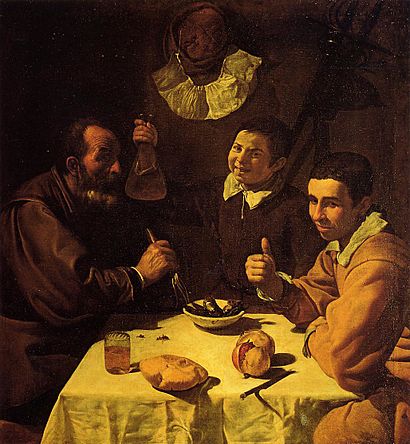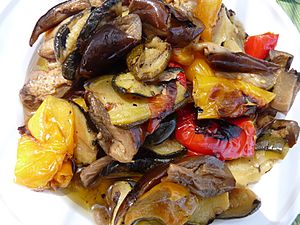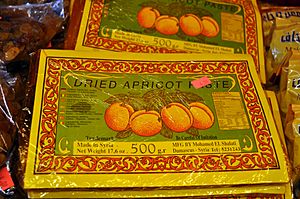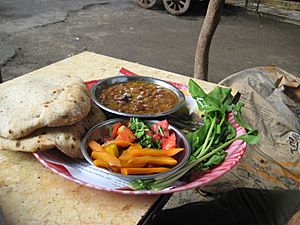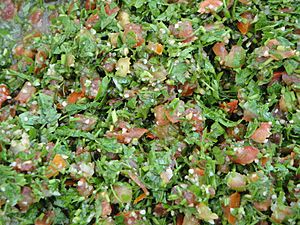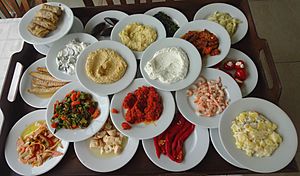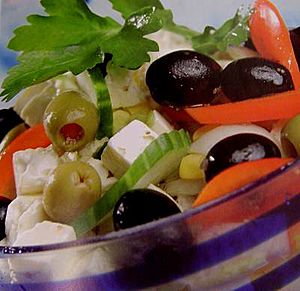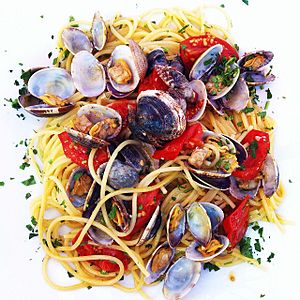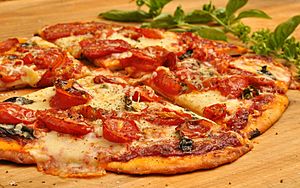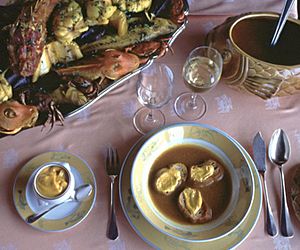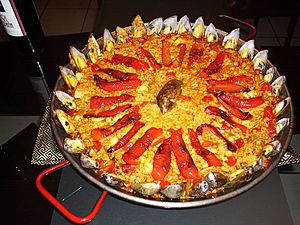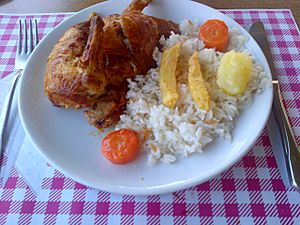Mediterranean cuisine facts for kids
Mediterranean cuisine is all about the delicious food and cooking styles used by people living around the Mediterranean Sea. Think of it as a big family of foods from different countries that share some things in common. The idea of "Mediterranean cuisine" became popular thanks to a cookbook writer named Elizabeth David in 1950.
Many people say that three main things are at the heart of this cooking: the olive, wheat, and the grape. These give us olive oil, bread (and pasta), and wine. However, some people think the foods from the Mediterranean are so different that they can't be called just one type of cuisine. Elizabeth David suggested that the area where olive trees grow is a good way to define the Mediterranean food region.
This big region includes many different cultures with their own unique foods. Some of these are from North Africa (like Maghrebi food), Egypt, the Middle East (like Levantine food), Turkey, Greece, Italy, France (especially Provençal food), and Spain. Even Portuguese cuisine has some Mediterranean qualities, even though Portugal is on the Atlantic Ocean.
Because these areas have been connected for a long time and share a similar climate, they also share some dishes. These include roasted lamb, meat stews with vegetables and tomatoes (like Spanish andrajos), vegetable stews (like French ratatouille and Italian ciambotta), and a special salted fish roe called bottarga. Many countries around the Mediterranean also enjoy drinks flavored with anise.
It's important not to confuse Mediterranean cooking with the Mediterranean diet. The diet is a healthy way of eating that focuses on olive oil, grains, fruits, vegetables, and seafood, with less meat and dairy. Mediterranean cuisine, however, is simply about how these foods (and others, including meat) are prepared, whether they are super healthy or not.
Contents
Where is Mediterranean Cuisine Found?
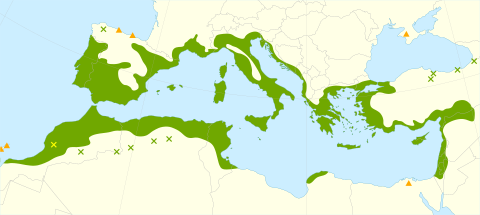
Writers often describe Mediterranean cooking based on where it comes from or what its main ingredients are.
Elizabeth David, in her 1950 book, said her focus was on "the cooking of the Mediterranean shores." She described the area stretching from Gibraltar to the Bosporus in Turkey, including places like Marseille, Barcelona, Genoa, Tunis, and Alexandria. It also includes all the Mediterranean islands like Corsica, Sicily, Sardinia, Crete, Cyprus, and the mainland of Greece, Syria, and Lebanon.
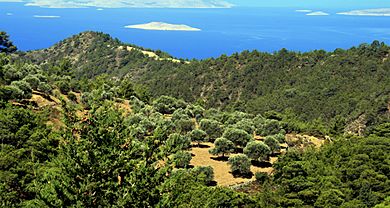
She linked this region to where the olive tree naturally grows. Olive trees need a warm climate without too much frost or too little water. This means they mostly grow in a narrow strip around the Mediterranean Sea. In places like the Maghreb (North Africa) and Spain, they grow more widely.
A historian named Mohamed Yassine Essid also defines the region by the presence of olives, wheat, and grapes. He calls these the "basic products of Mediterranean folk cuisine." He believes these elements show a shared culture that goes beyond different religions and languages.
However, some people wonder if there's truly one "Mediterranean cuisine." They argue that the food in one part of Italy can be very different from another, and comparing it to Greek food might seem strange. They believe that a "unified Mediterranean" food only seems to exist when you look at it from far away.
Some writers include the foods from the eastern Adriatic Sea coast, like Albania, Montenegro, and Croatia. Others even include areas that don't touch the Mediterranean Sea, like Serbia, Macedonia, and Portugal.
Main Ingredients
Mohamed Yassine Essid calls the olive, wheat, and grape the "trinity" of basic ingredients in traditional Mediterranean cooking. They give us olive oil, bread, and wine. An archaeologist named Colin Renfrew calls this the "Mediterranean triad."
Olive
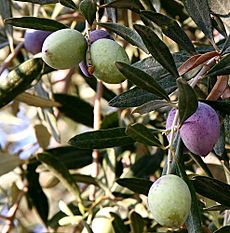
The olive tree likely came from the Persia and Mesopotamia region about 6,000 years ago. It then spread to nearby areas. People have been growing olives since the early Bronze Age (around 3,150 BC) in southern Turkey, the Levant, and Crete. The top ten countries that grow the most olives are all near the Mediterranean. Together, they produce 95% of the world's olives.
Olives are naturally bitter, but they become edible after being cured and fermented. About 90% of the olives grown are used to make olive oil. People in the Mediterranean region use the most olive oil in the world. For example, in 2014, Greece used 17 kilograms per person, while Italy used 12 kg and Spain used 13 kg. The United States, for comparison, used only 1 kg per person.
Wheat

Wheat was first grown by people in the Fertile Crescent (near the Levant) about 10,000 years ago. Early forms of wheat were cross-bred and planted to create stronger types with bigger grains. Wheat spread across the Mediterranean region, reaching Spain by 5,000 BC.
Wheat is a very important food in the Mediterranean area. Wheat bread was super important in the Roman Empire, which covered the whole region. Back then, about 2,000 years ago, North Africa was known as the "breadbasket" of the empire. Other common Mediterranean foods made from wheat include pasta and semolina products like couscous and bulgur. These are used in dishes like the Greek dessert galaktoboureko, which has filo pastry and a semolina custard. A popular wheat dessert from Turkey to India is halva, made from sweetened semolina with butter, milk, and pine kernels.
Grape

Grapes were first grown by people between 7,000 and 4,000 BC, in the area between the Black Sea and Persia. We know that wine was being made there by 6,000 BC. Grapes reached Greece and Crete around 5,000 BC and Spain by 1,000 BC. Winemaking started in Italy in the 800s BC and in France around 600 BC.
Most grapes are grown to make wine and vinegar, which are key parts of the Mediterranean diet. Grapes are also dried to make raisins or eaten fresh as table grapes. Raisins and table grapes are chosen for their great taste. Grape growing is still very important in the Mediterranean area. Southern Europe produces 21% of the world's grapes. In 2014, Italy grew 6.9 million tons of grapes, Spain 6.2 million tons, and France 6.2 million tons.
History of the Idea
The idea of "Mediterranean cuisine" is quite new. It probably started when Elizabeth David's book A Book of Mediterranean Food came out in 1950. She didn't even use the exact term "Mediterranean cuisine," but talked about "Mediterranean food" or "cooking."
Some experts, like Carol Helstosky, use "Mediterranean cuisine" to mean all the food from the region. She says that popular foods like pasta, pizza, gyros, and falafel are found almost everywhere.
Mohamed Yassine Essid believes that even though different Mediterranean countries have their own food traditions, they share common ways of preparing and eating food. He says that no matter where you go in the Mediterranean, you'll find a familiar way of cooking and eating.
However, other experts, like Sami Zubaida, argue that the idea of one "standard Mediterranean" food is a modern idea created by food writers. He says that the Mediterranean actually has many different cultures and foods.
Clifford A. Wright, another food writer, said in 1999, "There really is no such thing as 'Mediterranean cuisine'." But he also said that we generally understand what people mean when they use the phrase. He pointed out that Elizabeth David's book mostly focused on French Mediterranean food.
Since David's book, many other books about Mediterranean cuisine have been written, covering different parts of the region.
Where Did the Ingredients Come From?
The ingredients in Mediterranean cooking are different from those in Northern Europe. For example, they use olive oil instead of butter and wine instead of beer. The foods available have changed a lot over hundreds of years.
One big change happened in the Middle Ages when the Arabs brought many new foods to Portugal, Spain, and Sicily. These foods included aubergines, spinach, sugar cane, rice, apricots, and citrus fruits. This created the special cooking style of Al-Andalus (the parts of Spain ruled by Arabs).
Another huge change was when foods from the Americas arrived in Europe around the 1500s. While the potato became very popular in Northern European cooking, the tomato was quickly adopted into Mediterranean cuisine. The tomato, which is now so central to Mediterranean food, was first written about in 1544. Also, many types of beans used today, like the French or haricot bean, were brought back from the Americas by Spanish and Portuguese explorers.
Cooking Styles
Elizabeth David described the cooking of Mediterranean countries as being shaped by the climate, the soil, and the people.
She pointed out that some ingredients appear again and again in this large region. These include olive oil, saffron, garlic, strong local wines, and the lovely smell of herbs like rosemary, wild marjoram, and basil. She also mentioned the bright colors of fresh foods in the markets, like pimentos, aubergines, tomatoes, olives, melons, and figs, as well as shiny fish. She also included cheeses made from sheep's or goat's milk, and "sheets of apricot paste which is dissolved in water to make a cooling drink."

With common ingredients like olives, wheat, and grapes, a shared climate, and a long history of people sharing ideas, you might expect one single Mediterranean cuisine to have developed. And some foods are indeed found all around the Mediterranean. These include olive oil, bread, wine, roasted lamb (like Maghrebi méchoui and Greek kleftiko), bottarga, and stews of meat with vegetables and tomato (like Spanish andrajos and Italian ciambotta). Seafood like sea bream and squid is also eaten, often in stews or fried, in Spanish, French, and Italian dishes.
However, even with these similarities, the countries around the Mediterranean Sea have their own distinct regional foods. These range from the Maghrebi, Levant, and Ottoman styles to Italian, French, and Spanish. And each of these, in turn, has its own national and local differences.
Maghrebi Cuisine
Mediterranean Maghrebi cuisine includes the foods of Algeria, Libya, Morocco, and Tunisia. One of the most famous dishes is couscous. This is a steamed, small-grained wheat semolina served with a stew. Couscous is an ancient dish, mentioned by the traveler Ibn Battuta long ago. It's even found in Western Sicily, where it was brought back after the 1600s.
A stew often served with couscous is the Moroccan tagine. This is a rich dish of meat and vegetables, cooked slowly in a special pot (also called a tagine) with a tall, cone-shaped lid. Dishes from the Maghreb region of North Africa often get their color and flavor from hot spice mixes like harissa and ras el hanout. These mixes can include spices like cumin, coriander, saffron, cinnamon, cloves, chilies, and paprika. Other common flavors in the region are preserved lemons and dried apricots and raisins.
Egyptian Cuisine
Egyptian cuisine has very old roots. There's proof that cheese was made in Egypt as far back as 3,000 BC. Falafel are small fried patties made from bean or chickpea flour. They are now eaten across the Middle East and the West, but they started in Egypt during Roman times. Coptic Christians in Egypt claim them as their own. Duqqa is a dip made from crushed herbs, hazelnuts, and spices, eaten with bread. Kushari is a vegan dish of rice, lentils, and pasta, with different toppings. It started as food for poor people but has become a national dish.
Levantine Cuisine
Levantine cuisine is the cooking from the Levant region, which includes the Middle Eastern coast of the Mediterranean, east of Egypt. Some of the most famous foods from this cuisine are traditional small meze dishes like tabbouleh, hummus, and baba ghanoush. Tabbouleh is a dish of bulgur (cracked wheat) with tomatoes, parsley, mint, and onion, dressed with olive oil and lemon juice. Baba ghanoush, sometimes called "poor man's caviar," is a smooth dip made from aubergine with olive oil. It's often mixed with chopped onion, tomato, cumin, garlic, lemon juice, and parsley. This dish is popular all over the Eastern Mediterranean and North Africa.
Ful medames, which started in Egypt and is still a national dish there, is made of fava beans with oil and cumin. It's popular throughout the Levant. This dish might be very old, as dried beans from the Stone Age have been found near Nazareth.
Ottoman Cuisine
Ottoman cuisine led to the foods of modern Turkey, parts of the Balkans, Cyprus, and Greece. A special part of this cuisine is the family of small, flaky pastries called börek. These are very popular and found all over the Eastern Mediterranean. They date back to ancient Roman times. Börek are made from thin sheets of filo pastry, filled with things like meat, caramelized onion, and sweet peppers.
Another popular dish is moussaka. This is a baked dish with layers of aubergine or potato and other ingredients. It often has minced meat and tomatoes, sometimes with a layer of egg custard or béchamel sauce on top. The Greek version, which is well known outside the region, has layers of aubergine and minced meat with custard or béchamel sauce on top. This specific version was created by a chef named Nikolaos Tselementes in the 1920s.
Greek Cuisine
Greek cooking uses a lot of vegetables, olive oil, grains, fish, wine, and meat (like lamb, poultry, rabbit, and pork). Other important ingredients include olives, cheese, aubergine, courgette, lemon juice, herbs, bread, and yoghurt. Some dishes that go back to Ancient Greece are lentil soup, fasolada, retsina (white or rosé wine flavored with pine resin), and pasteli (sesame seeds baked with honey). Dishes from the Roman times include loukaniko (dried pork sausage). From the Byzantine period, we have feta cheese, avgotaraho (bottarga), and paximadhia (rusk). Many Greek dishes have names that show their Arabic, Persian, or Turkish roots, like moussaka, tzatziki, and keftes.
Italian Cuisine
Mediterranean Italian cuisine covers most of Italy, except for the far north and the mountains. It's a very diverse cuisine, but some of its most famous foods are risotto, pizza (especially in Naples and Sicily), and pasta dishes like spaghetti.
Risotto is made with Italian short-grain rice. This rice is very good at soaking up liquid and stays firm when cooked with broth and flavored with onions and garlic in butter. There are many types of risotto, with additions like fish, chicken, mushrooms, cheese, quails, beef, courgettes, clams, ragù, beans, mussels, prawns, cuttlefish, and asparagus.
Pizza is a thin piece of bread dough with toppings. The toppings change depending on the place, but they are usually much simpler than what you might find in other countries. In Naples, it's often tomato, anchovies, and buffalo mozzarella. In San Remo, it's onions cooked in olive oil with salted sardines. The Provençal (French) version uses onions, black olives, and anchovies.
Spaghetti dishes also vary. It can be eaten simply with olive oil and garlic, without cheese. Or it can have a sauce of "very red and ripe peeled tomatoes," cooked quickly and flavored with garlic and either basil or parsley. A Sicilian version includes pieces of bacon, onions fried in fat, garlic, pitted olives, and anchovies, served with olive oil and grated Parmesan cheese.
French Cuisine
Mediterranean French cuisine includes the cooking styles of Provence, Occitania, and the island of Corsica. Famous dishes that use local ingredients include bouillabaisse and salade niçoise.
Bouillabaisse is a big, hearty fish stew from the French port of Marseille, the capital of Provence. It's usually made for at least eight people because it should have many kinds of fish, like crayfish, gurnard, weever, John Dory, monkfish, conger eel, whiting, sea bass, and crab. These are cooked with Mediterranean vegetables and herbs, such as onions, garlic, tomatoes, thyme, fennel, parsley, bay leaves, and orange peel.
Salade niçoise is a colorful salad with tomatoes, tuna, hard-boiled eggs, Niçoise olives, and anchovies, dressed with a vinaigrette.
Spanish Cuisine
Spain's diverse Mediterranean foods include the cooking of Andalusia, Murcia, Catalonia, Valencia, and the Balearic islands. Paella is a famous Spanish dish, originally from Valencia. It quickly spread to Catalonia and Murcia along Spain's Mediterranean coast. There are many versions of paella. It can have a mix of chicken, pork, rabbit, or shellfish, cooked in olive oil in a large, shallow pan. Vegetables and round-grain rice (often local varieties like albufera or bomba) are added, and the rice cooks to soak up the water, colored with saffron. You can also add artichoke hearts, peas, sweet peppers, lima beans, string beans, or sausages.
Portuguese: Partly Mediterranean
Portugal is on the Atlantic Ocean, not the Mediterranean Sea. However, it's in the Mediterranean basin, with olive groves and a Mediterranean climate (except for the wetter Atlantic coast). So, its food is partly Mediterranean, using the common trio of bread, wine, and olive oil. But it's also partly Atlantic, with a strong tradition of fishing and many seafood dishes. These include seafood rice (arroz de Marisco), clams, squid (lulas grelhadas), and bacalhau (imported salted cod).
There are also many meat dishes, using chicken, pork, and rabbit. Other important ingredients are onions, garlic, bay leaves, sweet peppers (pimentão), cloves, and chouriço sausage. Portuguese vegetables include tomatoes, common in Mediterranean food, but also kale, carrots, and broad beans. Sweet dishes include pastéis de nata, which are custard tarts with cinnamon. Portugal also makes red wines like Alentejo.
Anise Spirits
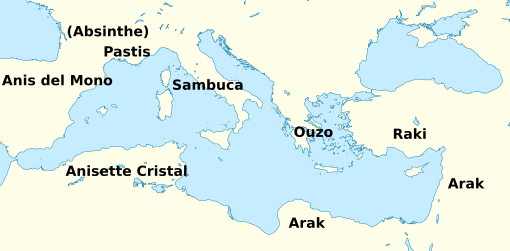
Anise is used around the Mediterranean to flavor different traditional alcoholic drinks, including:
- French pastis and absinthe
- Greek ouzo
- Italian sambuca
- Spanish anísado
- Balkan rakı
- Lebanese, Libyan, Syrian, Jordanian, Israeli, and Palestinian arak
- Algerian anisette cristal
Mediterranean Diet and Cuisine
The Mediterranean diet, which became popular in the 1970s, was inspired by the way people ate in parts of Greece and Italy in the early 1960s. The American Diabetes Association talks about "Mediterranean-Style Eating." They mention the traditional Mediterranean way of life, which includes "eating healthfully ... together among family and friends." They also say that "Mediterranean cuisine is plant-based," meaning most foods come from plants like "whole grains, fruits, vegetables, herbs and spices, beans, nuts, seeds, and olive oil."
In 1984, an Italian food guide noted that Americans discovered the "Mediterranean diet." Italian government officials liked the name but changed "diet" to "cuisine" because "diet" sounded like a punishment.
A Changing Cuisine
Since Elizabeth David wrote about Mediterranean food in 1950, and since researchers found in the 1950s that people around the Mediterranean had less heart disease, the traditional ways of life and eating have changed. With more money and busy lives, people now eat more meat and fewer vegetables. Their diet is becoming more like Northern European diets, with more convenience foods. This means it might not have the same protective effect against heart disease as the traditional Mediterranean diet.
See also
 In Spanish: Gastronomía mediterránea para niños
In Spanish: Gastronomía mediterránea para niños


